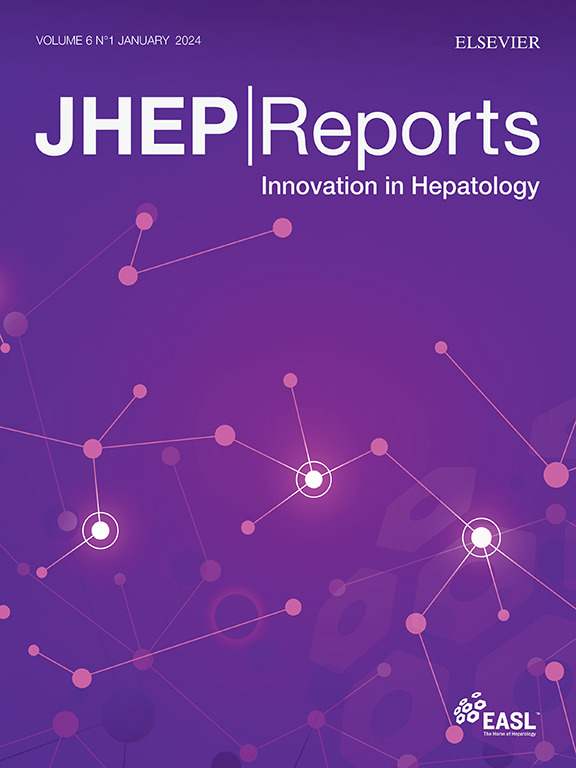Lipidomics-based plasma signature of alcohol-related hepatitis linked to short-term mortality
IF 9.5
1区 医学
Q1 GASTROENTEROLOGY & HEPATOLOGY
引用次数: 0
Abstract
Background & Aims
Severe alcohol-related hepatitis (sAH) is an inflammatory condition with high short-term mortality. Hypothesis-driven approaches have failed to identify effective treatments. Given the role of lipids as inflammatory mediators, this study aimed to identify lipidomic changes and lipid species associated with sAH and mortality risk.
Methods
Untargeted lipidomics was performed on serum samples from two cohorts of patients with sAH and decompensated cirrhosis (DC). Principal component analysis and orthogonal partial least squares discriminant analysis were used to assess lipidome changes. Correlations were made with lipoproteins, lipid mediators, cytokines, cytokeratin fragments, and histological indices.
Results
In the first part, 78 patients with sAH were matched on bilirubin levels with 23 patients with DC. Lipidomics identified a distinct sAH signature involving glycerophospholipids, including PC(34:2) (odds ratio [OR] 2.18, 95% confidence interval [CI] 1.45–7.05, p = 0.01), PC(O–38:5) (OR 3.31, 95% CI 2.23–7.14, p = 0.002), PI(38:4) (OR 0.71, 95% CI 0.46–0.88, p = 0.02), and LPC(18:1) (OR 0.47, 95% CI 0.32–0.82, p = 0.01). These lipids demonstrated excellent discriminatory power between sAH and DC with areas under the receiver operating characteristic curve (AUROCs) between 0.87 and 0.88. In the second part, in 159 sAH patients, specific lipids, including carnitines CAR(2:0) (OR 2.51, 95% CI 1.25–4.96, p = 0.008) and CAR(16:1) (OR 2.21, 95% CI 1.09–7.48, p = 0.009), were linked to 90-day mortality. Acylcarnitines correlated with disease severity parameters such as model for end-stage liver disease, pro-inflammatory cytokines levels, and hepatocyte ballooning on pathology.
Conclusions
Untargeted lipidomics identified a glycerophospholipid and sphingolipid signature distinguishing sAH from DC, implicating lipid species involved in liver regeneration and immune function. Acylcarnitine accumulation in patients with sAH and poor prognosis suggests mitochondrial dysfunction and warrants further investigation into therapeutic potential.
Impact and implications
Lipids can act as mediators at the interface between the immune system and metabolism, potentially contributing to the pathogenesis and outcomes of patients with severe alcohol-related hepatitis, prompting us to investigate lipidomic changes in this population using untargeted approaches, compared with patients with decompensated cirrhosis. This study highlights a distinct lipidomic signature in patients with severe alcohol-related hepatitis compared with decompensated cirrhosis, primarily involving glycerophospholipids and sphingolipids. Specific lipid classes, such as acylcarnitines, suggest significant mitochondrial dysfunction and are associated with disease severity and short-term mortality in patients with severe alcohol-related hepatitis. These findings underscore the importance of targeted investigations into these lipid species, their pathways, and their links to disease severity and outcomes, particularly in this condition that currently lacks specific treatments.

基于脂质组学的酒精性肝炎与短期死亡率相关的血浆特征
背景,目的重度酒精相关性肝炎(sAH)是一种短期死亡率高的炎症性疾病。假设驱动的方法未能确定有效的治疗方法。鉴于脂质作为炎症介质的作用,本研究旨在确定与sAH和死亡风险相关的脂质组学变化和脂质种类。方法对两组sAH和失代偿性肝硬化(DC)患者的血清样本进行靶向脂质组学分析。采用主成分分析和正交偏最小二乘判别分析评价脂质组的变化。与脂蛋白、脂质介质、细胞因子、细胞角蛋白片段和组织学指标相关。结果在第一部分中,78例sAH患者的胆红素水平与23例DC患者匹配。脂质组学鉴定出明显的sAH特征与甘油磷脂有关,包括PC(34:2)(比值比[OR] 2.18, 95%可信区间[CI] 1.45-7.05, p = 0.01)、PC(0 - 38:5)(比值比[OR] 3.31, 95% CI 2.23-7.14, p = 0.002)、PI(38:4)(比值比[OR] 0.71, 95% CI 0.46-0.88, p = 0.02)和LPC(18:1)(比值比[OR] 0.47, 95% CI 0.32-0.82, p = 0.01)。这些脂质在sAH和DC之间表现出良好的区分能力,接收器工作特征曲线下面积(auroc)在0.87和0.88之间。在第二部分中,在159例sAH患者中,特定脂质,包括肉碱CAR(2:0) (OR 2.51, 95% CI 1.25-4.96, p = 0.008)和CAR(16:1) (OR 2.21, 95% CI 1.09-7.48, p = 0.009)与90天死亡率相关。酰基肉碱与疾病严重程度参数相关,如终末期肝病模型、促炎细胞因子水平和病理上的肝细胞球状化。结论太阳靶向脂质组学鉴定出sAH和DC的甘油磷脂和鞘脂特征,提示脂质种类参与肝脏再生和免疫功能。sAH患者的酰基肉碱积累和预后不良提示线粒体功能障碍,值得进一步研究其治疗潜力。影响和意义脂质可以作为免疫系统和代谢之间的界面介质,可能有助于严重酒精相关性肝炎患者的发病机制和结局,促使我们使用非靶向方法研究这一人群的脂质组学变化,并与失代偿肝硬化患者进行比较。这项研究强调了严重酒精相关性肝炎患者与失代偿肝硬化患者的明显脂质组学特征,主要涉及甘油磷脂和鞘脂。特定的脂类,如酰基肉碱,提示严重的线粒体功能障碍,并与严重酒精相关性肝炎患者的疾病严重程度和短期死亡率相关。这些发现强调了有针对性地研究这些脂质物种、它们的途径以及它们与疾病严重程度和结果的联系的重要性,特别是在目前缺乏特异性治疗的情况下。
本文章由计算机程序翻译,如有差异,请以英文原文为准。
求助全文
约1分钟内获得全文
求助全文
来源期刊

JHEP Reports
GASTROENTEROLOGY & HEPATOLOGY-
CiteScore
12.40
自引率
2.40%
发文量
161
审稿时长
36 days
期刊介绍:
JHEP Reports is an open access journal that is affiliated with the European Association for the Study of the Liver (EASL). It serves as a companion journal to the highly respected Journal of Hepatology.
The primary objective of JHEP Reports is to publish original papers and reviews that contribute to the advancement of knowledge in the field of liver diseases. The journal covers a wide range of topics, including basic, translational, and clinical research. It also focuses on global issues in hepatology, with particular emphasis on areas such as clinical trials, novel diagnostics, precision medicine and therapeutics, cancer research, cellular and molecular studies, artificial intelligence, microbiome research, epidemiology, and cutting-edge technologies.
In summary, JHEP Reports is dedicated to promoting scientific discoveries and innovations in liver diseases through the publication of high-quality research papers and reviews covering various aspects of hepatology.
 求助内容:
求助内容: 应助结果提醒方式:
应助结果提醒方式:


